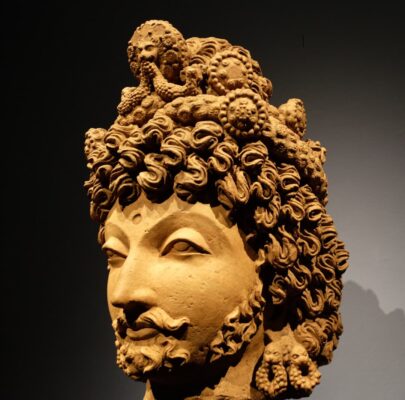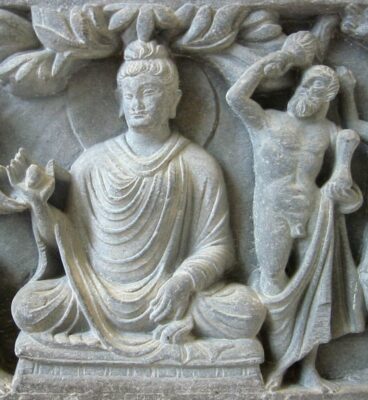Arte de la Antigua Gandhara
Encrucijada de civilizaciones
“Nuestras ruinas de Butkara eran un lugar mágico para jugar al escondite. Una vez llegaron unos arqueólogos extranjeros para hacer un trabajo allí y nos contaron que en tiempos pasados era un lugar de peregrinación, lleno de hermosos templos con cúpulas doradas donde yacían enterrados los reyes budistas. Mi padre escribió un poema, «Las reliquias de Butkara», que resumía perfectamente cómo podían coexistir el templo y la mezquita: «Cuando la voz de la verdad se eleva desde los minaretes, / el Buda sonríe, / y la cadena rota de la historia vuelve a conectarse».”
Malala Yousafzai, “Yo soy Malala: La niña que defendió la educación y fue tiroteada por los talibanes”
Imágenes: Cabeza de Bodhisattva, Gandhara, alrededor del siglo IV d.C., terracota, 85 cm de altura ·· Relieve de Vajrapāṇi como guardían de Buda, siglo II d.C. Museo Británico. Licencia Creative Commons Attribution-Share Alike 3.0 Unported
En la región histórica de Gandhara –que se corresponde al norte de lo que hoy es Pakistán, incluyendo también parte del este de Afganistán y el noroeste de India (Cachemira)- floreció un estilo artístico único, budista en su fondo y griego en sus formas, testimonio de la incorporación de elementos occidentales al arte oriental de la región tras su conquista por parte de Alejandro Magno.
En el arte greco-budista de Gandhara, las tradicionales figuras de Buda o Bodhisattva a menudo muestran elementos típicos del arte griego, como cabelleras rizadas o la pose en contrapposto. Los elementos de la arquitectura griega (como los capiteles corintios) están presentes en los templos de Butkara Stupa o Ai-Khanoum. Esta fusión de elementos orientales y occidentales, llevada al extremo, puede observarse en un relieve del Museo Británico (ver imágenes), en el que la figura de Vajrapāṇi, guardián de Buda, se representa como un típico héroe griego, habitualmente identificado con Hércules.
Por supuesto, el arte existía en Gandhara antes de la llegada de los conquistadores griegos, existiendo ejemplos como las cerámicas de la Cultura de las tumbas de Gandhara (1500 – 500 a.C.). Pero son las imágenes del arte greco-budista las que hacen de esta región un lugar único y una cultura fascinante para todos aquellos interesados en la historia y la cultura del mundo, y las que nos hacen lamentarnos del sinsentido de la destrucción, por parte de los talibanes, de los colosales Budas de Bāmiyān en 2001.
G. Fernández · theartwolf.com
Leer más (enlace externo)
[wikicard title=»Arte_greco-budista» lang=»es»]
Follow us on:


